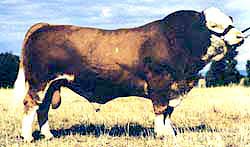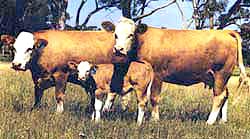
Cattle breeds: Simmental
Origin
The breed originated in the Simme Valley of Switzerland during the 18th century, and the first Herd Book was established in 1806. The breed has since developed along specific lines throughout Europe, the United Kingdom, the Soviet Union, South Africa, the Americas and Australasia. Known by local names in Europe such as Pie Rouge (France) and Fleckvieh (Germany), the ‘simmental’ breeds may be fullblood or upgraded purebred Simmentals. They vary in type according to the demands of the local environment and market requirements.
World Simmental Federation statistics put the number of Simmental cattle worldwide at over 40 million head, making them second only to Zebu in worldwide numbers.
Importation of semen into Australia commenced in April 1972 with both German and Swiss strains. In later years many Simmentals were imported through New Zealand and this, together with access to semen from North America, has expanded the gene pool.
Distribution in Australia
The breed has rapidly increased in number since the early imports and is now well established in most parts of Australia in areas as diverse as the Kimberleys and Tasmania. There are over 70 000 registered Simmentals in addition to the thousands of Simmental-infused commercial cattle.
Breed characteristics

Simmentals vary from yellowish brown to straw colour to dark red, with white markings on the head, brisket, belly and legs. They often have red pigmentation around the eyes, and white patches on the body, especially behind the shoulders and on the flanks. Ideally the hair is soft and short. The breed is naturally horned although breeders are producing polled Australian purebred cattle.
Simmentals are well-muscled animals, being long and deep-bodied with strong bone. They have good temperament and high milk production.
Simmental carcases are significantly heavier and leaner than other European breeds, with little waste, and they give a higher yield of saleable meat.
The breed is ideal for crossbreeding, particularly with Herefords, giving even lines of red and white cattle which can be selected to suit a range of markets.
Black Simmental
In the early 1990’s American Simmental breeders sought to change their breed to better captured the market essentials important to the cattle industry and consumers.
Simmentals already possessed excellent maternal traits, growth and yield. They added to this the eating quality of Angus, polledness, earlier maturity, eye pigment (no eye cancers) and calving ease, to create the Black Simmental.
One of the Simmental breed’s biggest advantages is its adaptability. Breeders around the world have created animals that uniquely suit their environment or purpose.
The origins of Black Simmental were the result of mating Simmental to Angus. Over time a small number of breeders continued to utilise a grading up program from animals possessing the dominant black gene to reach a “pure” Simmental status. Purebred Black Simmentals are black in coat colour, contain at least 15/16 Simmental content and are registered in the society’s Black Simmental register.
Red Simmental
The Red Simmental evolved from strains of Simmental and Black Simmental displaying more red colouring on the head, body and legs. Importantly they possess red eye pigmentation.
Purebred Red Simmental cattle must have at least 15/16 Simmental content and are registered in the society’s Red Simmental register. Today, Red Simmental are predominantly solid red coated and polled.
Red Simmental are particularly useful in crossbreeding systems with other red coated breeds and composites to maintain the red coat colour while utilising the many production advantages of Simmental. Red Simmentals possess all the valuable traits of the Simmental breed, differing only in coat colour, which is predominantly red and with less white markings than the Simmental.
Further information
For further information, Simmental Australia at:

Australian Simmental Breeders Association
PO Box 216
Inverell NSW 2360
Ph: +61 488 062 287
Website: www.simmental.com.au
Acknowledgment
The author thanks Simmental Australia for their help in preparing this Agfact.

